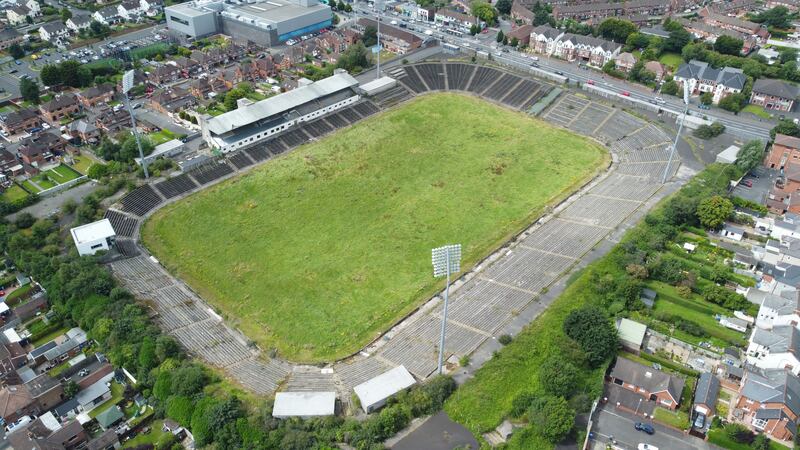Thursday morning, Andersonstown Road, west Belfast and outside Casement Park six words from the past are beating on the door. They form a sentence, deceptively simple: “Irish football is a complex subject.”
These are the first six words of the preface to Malcolm Brodie’s 1963 book, The History of Irish Soccer. They were the words Brodie settled on to sum up how he would introduce the previous 83 years of organised football on the island of Ireland. Brodie did not choose joy or glory as his introduction. No, Irish football is a complex subject.
Sixty years on, were Brodie still around, the words would be worth scrawling across the perimeter hoardings concealing much of a derelict GAA ground.
[ What is the current situation with Casement Park’s redevelopment?Opens in new window ]
Instead there are quotations from Roger Casement – “death is not dark but only deeper blue” – fading posters promoting a Jimmy Steele memorial and stencilled graffiti saying “open your eyes” and “start asking questions”. Each says something about where we are in Belfast and where Irish football is in this pivotal corner of the land.
That last urging has been part of the environment long before it was stuck on a board, but since Tuesday’s announcement that the 2028 European Championships are to be held in Britain and Ireland, the questions have rolled in hourly.
Beyond Belfast it has been: what is Casement Park? Where is Casement Park? Why is Casement Park the venue selected for this city to host matches in this tournament?
Some answers have been factual by nature: Casement Park has been chosen because Uefa require a 30,000-capacity stadium for matches and Windsor Park, home of Northern Ireland’s team, holds 18,500 and does not have the logistical room to expand.
Others need to be factual, such as: What will the actual cost be? Who builds it, now that one of the proposed contractors has gone bust? How does the surrounding area cope?
But some answers are not factual, they sit in another realm. It is one with which we are all too familiar.
How, for example, do we answer where Casement Park sits emotionally in the modern history of this city, never mind in Irish football? In 2023, what does the name Roger Casement signify?
Those who live here know their answer and it is each to their own.
Elsewhere, though, they require background and guidance and it could leave them asking why, just more than four years out from a major tournament, a site has been found that is (a) not built (b) not a soccer ground and (c) controversially political in a place where that has cost so many lives?
They are not unreasonable queries. The Amalgamation of Northern Ireland Supporters Clubs (AONISC) provided a shortlist of questions including: Where is the legacy for local football? What consideration has been given to the logistical and safety issues that may arise given the divided nature of Northern Ireland’s society?

The first is a valid sporting concern – Irish League infrastructure is every bit as dilapidated as the League of Ireland’s and to offset some local angst, the much-needed redevelopment of Glentoran’s Oval, for instance, would be a welcome announcement. The second question is a recognition of daily life in a city where there may be no war, but there is not true peace either.
This is a place where local government at Stormont does not sit, where politicians who still take salaries and expenses query the price of a stadium.
[ Euro 2028 comes to the rescue of much put-upon Casement Park projectOpens in new window ]
The walled-off, flag-strewn streets are a sign to stick to your own territory and people do. There are those on the Falls Road and Shankill Road who have never set foot on the other even though they are parallel. The idea that fans from Shankill will suddenly stroll carefree up the Falls because Uefa are in town, and that the residents of Andersonstown will happily sing God Save the King once Casement Park is arrived at, is, shall we say, misplaced.
Another valid AONISC question is: What is plan B if Casement Park is not completed within the required timescale?
This really matters, because it begets the biggest question of all: What if Euro 2028 happens without Belfast?
Put your spade in the ground for a minute, step back and think about that.
Make no mistake, Uefa will have a contingency plan – they have tickets to sell, television companies to sell to and supply, sponsors to satisfy.
Uefa will move on, Euro 2028 will start with an avalanche of goodwill and good-natured imagery and Belfast will miss out. Euro 2028 will be seen across Europe and the world as a showcase for cities such as Dublin, Glasgow and Birmingham, and Belfast will look on. Fans from other countries will bounce into these cities for the first time, enjoy themselves and spend money. Some will return. For others it will be their first tournament and they will never forget the experience.
And Belfast will not be part of it.
That would represent a civic and sporting failure. It would be an embarrassment, an admission that while the citizens of Belfast and their alleged governors can tell you in detail about their past, they have not got a clue about how to manage the future. Worse, we’d hear again that piffle about how Irish rugby unites a divided land.
Belfast is a football city, it is part of its character. The airport is named after George Best. You fly in over Danny Blanchflower’s house in Bloomfield.
The game has been played on the streets of north Belfast since 1880 when Cliftonville became Ireland’s first club. The Irish Football Association (IFA), founded the same year in a city centre hotel, is the fourth-oldest association in the world. As Cormac Moore has written: “There were 110 clubs affiliated to the IFA in 1900. By 1910, there were 420.”
Pre-partition, Bohemians joined the Belfast-based Irish League in 1901 followed by Shelbourne in 1903. The penalty-kick was invented by a man playing in the Irish League, William McCrum. We are two years from the centenary of Fifa changing the offside law because of Bill McCracken. McCracken came from the bottom of the Falls and, if it matters to you, was a Protestant when that area was mixed.
The supporters of the mighty Belfast Celtic came from the same streets. Belfast Celtic were forced to leave the Irish League in 1949 due to a sectarian riot. Jimmy Hasty was murdered on Brougham Street. No Northern Ireland games could be played in the city between 1971 and 1975.
Yes, Irish football is a complex subject; particularly in great, grim Belfast.
All this, however, is the past. Euro 2028 is the future and for locals so is 2038 and 2048. Will the city’s children still be discussing 2023 and 1983? Can Belfast find the time to reconcile itself for its future, if not its past?
More questions.
You walk away from Casement Park and its padlocks, the ghost of Roger beating on the door of Irish football. It’s complex.

















